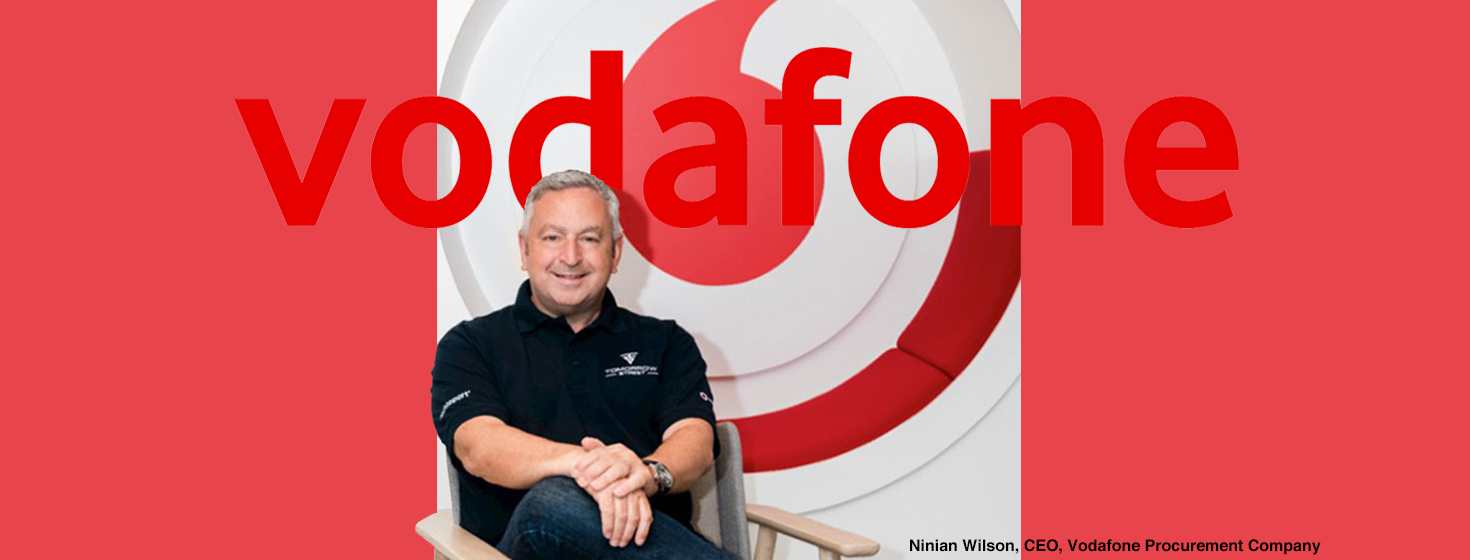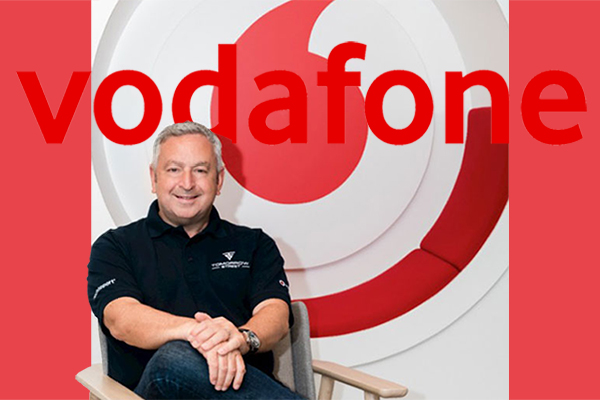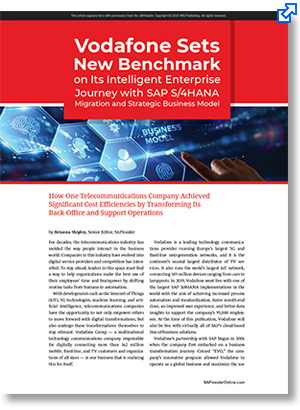Digitizing Vodafone’s Supply Chain Beginning with Procurement as a Major Focus

Bob Trebilcock, the executive editor of Supply Chain Management Review, recently interviewed Ninian Wilson, global supply chain director, and CEO of the Vodafone Procurement Company about Vodafone’s digital journey.
All Talk No Action
If you’re from a certain part of the U.S., you’re familiar with the phrase: All hat, no cattle.
It’s a more colorful way of saying: All talk, no action.
In the supply chain, there’s a lot of talk about digital transformation, but dig under the covers and only a few companies are taking action.
One of those is Vodafone, one of the world’s largest mobile operators, with more than 300 million customers worldwide.
Last month, I had the chance to speak to Ninian Wilson (pictured above), global supply chain director, and CEO of the Vodafone Procurement Company, the procurement organization of the parent company Vodafone.
We talked about Vodafone’s digital journey.
Vodafone’s Digital Journey
Ninian, tell us a little about the scope of Vodafone’s supply chain.
Our planned annual spend, which I oversee, is around 20 billion Euros. We have a staff of 800 working in the supply chain across three locations. For instance, we do strategic sourcing in Luxembourg and transaction activity in India. And, we have people from procurement embedded in each of our operating companies. We buy everything needed to make our mobile network work, from technology to marketing services, to trucks and vans to travel services for the organization.
Many digital transformations are driven by changes in the business model and customer expectations. What’s driving Vodafone’s business?
When I joined Vodafone 11 years ago, we were predominately a mobile company. Convergence was becoming a trend, where the customer buys their Internet, cable, and phone services from one vendor. So, strategically, we wondered whether we should move more into those spaces. If you look at our European footprint today, we’re the biggest network company and the number 2 cable company. As a result, what we’re buying is changing. Along with that, our mindset changed to become a more digital company.
The digital supply chain is certainly a topic of conversation today. As a procurement leader, what does that mean to you?
Let me give you three illustrations: Where we started four years ago, where we are today, and where we’re going. Early on, I got an email from our CFO that he wanted to visit and he wanted the procurement organization to digitize our supplier scorecards. We scratched our heads, went to work, and created a tool that standardized the business metrics. It went live the night before he came to visit us. Now, it wasn’t perfect, but we were able to say here’s where the transactions take place, here’s the value. And, it was as real-time as we need for the supply chain function. He asked 3 or 4 questions and within a few weeks, we had digitized those questions. That’s where we started.
Today, when I have my review with our current CFO, she can drill down into our KPIs and metrics. We’re aligned with the overall direction of the business, and if you’re not aligned, the life of a CPO can be very short. And the system we created has been rolled out across the business units.
Our next step was to try software packages from a number of vendors so we could figure out what was and what wasn’t real. If it worked we kept it, if it didn’t work, we turned it off. We implemented SAP S4/HANA, built a reservoir of data, and then put tools on top of that, including SAP Ariba solutions to digitize procurement. Now, I can tell you the payment history for small vendors at the push of a button; I can tell you exactly how much inventory I have. I can take you through my compliance POs and the deficient ones as well. I can tell you how much time it takes me to process a PO. There is no more discussion about whether the numbers are real. We can drill for the oil – if data is the new oil.
So, where are we going next? We just announced a program we’re calling Procurement With A Purpose for our RFPs. Now, that we’re getting more digital information on the vendors we work with, I want visibility into their Tier 2s and Tier 3s so I can manage more risk in the supply chain. You can only get that level of transparency in a digital supply chain, and we’re working with SAP and its SAP Ariba solutions to do that.
Does digitalization extend outside of procurement?
Yes. Our corporate strategy is to digitize society through the services we offer our customers. To do that, you have to digitize internally as well, and we’re doing that. During COVID, 95% of our people have worked from home and it has worked seamlessly. My last day in the Luxembourg office was a Tuesday and on Wednesday I was signing contracts digitally from home. The hardest part was figuring out in which room of the house to work.
Procurement With A Purpose extends into our corporate responsibility initiatives. We’re going to embrace supplier scoring on factors like the LGBT+ community.
If I can digitize logistics activities, I can do things like reducing the amount of airfreight we need, because I can plan better, which reduces our carbon footprint. We already have Artificial Intelligence (AI) in the supply chain, and moving forward, we’ll make it smarter to add more value.
A question we often hear from executives beginning a digital journey is: Where do I start? Where did you start at Vodafone?
We started with the supplier scorecard. There was that ‘wow!’ factor after the CFO visited us and gave us a license to do more. It snowballed from there. Next, we hired some data scientists to help us with the data.
If you want to have a procurement strategy for something like digitizing your travel or logistics spend, you have to start with a data strategy. That’s a big change for the supply chain in the future.
What are the lessons learned from your journey so far?
In the past, I may have spent 6 months trying to get a software system working when in my heart, I knew it wasn’t going to work. In today’s world, you can’t afford to move that slow. So, one of my learnings would be: When stuff ain’t working, move on to the next experiment, but make sure that you share the lessons of what went wrong with everyone.
Secondly, don’t believe the hype. Everyone has PowerPoints; everyone says they can transform. When you’re entering nearly 900,000 purchase orders a year into the system, you have to see the product to see if it will work.
Where do you go next, and why?
Next is the digitalization of the physical supply chain. That’s a great opportunity. Then, autonomous procurement. Procurement with no human touch is in reach. Some of the technology is not fully mature, but you can see it coming. And, a month ago we implemented blockchain for price updates. The goal is as fast, simple, and autonomous as possible so we can focus on world-class procurement. The next five to six years will be tremendously exciting!
Article Topics
SAP News & Resources
SAP Unveils New AI-Driven Supply Chain Innovations JAGGAER Streamlines Supplier Management for Rolls-Royce Technology is Driving Innovation Across the Supply Chain AI Simulation Helps Supply Chains Predict the Future SAP’s Empowering Women in Supply Chain Aims to Forge Strong Female Leadership Optimizing Supply Chain Resilience for Sustainable Future Success Enterprise Resource Planning Gains Ground Into the Supply Chain Management Sector More SAPLatest in Supply Chain
Ask an Expert: How Shippers Can Prep for Hurricane Season Apple Accused of Multiple Human Rights Violations South Korea Finally Overtakes China in Goods Exported to U.S. UPS Struggles in First Quarter With Steep Earnings Decline How Supply Chains Are Solving Severe Workplace Shortages SAP Unveils New AI-Driven Supply Chain Innovations How Much Extra Will Consumers Pay for Sustainable Packaging? More Supply ChainAbout the Author















